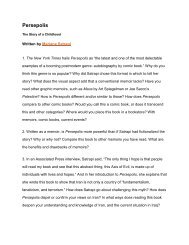Brief History of the Graphic Novel.pdf
Brief History of the Graphic Novel.pdf
Brief History of the Graphic Novel.pdf
Create successful ePaper yourself
Turn your PDF publications into a flip-book with our unique Google optimized e-Paper software.
<strong>Brief</strong> <strong>History</strong> <strong>of</strong> <strong>the</strong> <strong>Graphic</strong> <strong>Novel</strong><br />
by Stan Tychinski<br />
Since <strong>the</strong> days <strong>of</strong> prehistoric man, people have been telling stories using pictures instead <strong>of</strong> prose. From <strong>the</strong><br />
cave paintings <strong>of</strong> <strong>the</strong> Cro-Magnon to <strong>the</strong> hieroglyphics <strong>of</strong> Ancient Egypt, graphic storytelling has been in use as<br />
a popular means for communicating thoughts and ideas.<br />
In most early civilizations, and well into <strong>the</strong> current century, <strong>the</strong> majority <strong>of</strong> <strong>the</strong> population was illiterate.<br />
Reading was a luxury for <strong>the</strong> well to do. Drawings and cartoons were used as a simple way to convey ideas or<br />
sentiments to <strong>the</strong> working class populace. As we entered <strong>the</strong> Industrial Age and began using machines to do<br />
work for us, <strong>the</strong>se working class people began to have more leisure time; time that was spent looking for<br />
entertainment. As more folks began reading, humor periodicals began to appear. Humor was an effective way to<br />
address social ills or political agendas. One <strong>of</strong> <strong>the</strong> best examples <strong>of</strong> this type <strong>of</strong> publication is POOR<br />
RICHARD'S ALMANAC, printed in 1732 by Benjamin Franklin. In it, Franklin used satirical cartoons to<br />
advance <strong>the</strong> cause <strong>of</strong> American Revolution.<br />
Ano<strong>the</strong>r popular form <strong>of</strong> entertainment periodical was <strong>the</strong> <strong>Novel</strong>, an early form <strong>of</strong> today's paperback book,<br />
usually illustrated, and involving a sensational adventure or mystery. Many were set in <strong>the</strong> American Wild<br />
West, and <strong>the</strong>y help popularize men like Davy Crockett and Buffalo Bill. Dime novels were also known as<br />
"penny dreadfuls."<br />
In 1842, <strong>the</strong> first major graphic novel was published in <strong>the</strong> United States. THE ADVENTURES OF OBADIAH<br />
OLDBUCK by humorist Rodolphe T<strong>of</strong>fler, appeared in a weekly humor magazine called Bro<strong>the</strong>r Jonathan. It<br />
concerned <strong>the</strong> misadventures <strong>of</strong> a young man and his "lady-louve", using captioned cartoons arranged in tiered<br />
or strip like fashion. THE YELLOW KID appeared in 1895, and quickly became <strong>the</strong> first successfully<br />
merchandised comic strip character. Created by Richard Outcault, The Yellow Kid was so popular that <strong>the</strong><br />
strip's presence actually increased newspaper sales. In 1897, <strong>the</strong> Hearst Syndicate released <strong>the</strong> first collected<br />
edition <strong>of</strong> Yellow Kid cartoons in book form. This best selling collection could be considered <strong>the</strong> very first<br />
financially successful graphic novel.<br />
Popular forms <strong>of</strong> entertainment periodicals began to appear in <strong>the</strong> United States after WW1, such as <strong>the</strong> Pulp<br />
novels. Named as such for <strong>the</strong> cheap pulp paper <strong>the</strong>y were printed on, <strong>the</strong>y usually featured adventure stories<br />
aimed at male readers, with topics such as war stories, westerns, and science fiction. As pulp publishers began<br />
to look for new genres and ways to expand <strong>the</strong>ir readership, <strong>the</strong>y hit upon <strong>the</strong> daily newspaper strips. In 1933,<br />
M.C. Gaines created <strong>the</strong> first comic book, called NEW FUNNIES, which reprinted daily comic strips. Later that<br />
year, a company called Humor Publications printed <strong>the</strong> first all original comic book, DETECTIVE DAN. And<br />
in 1938, everything exploded with <strong>the</strong> publication <strong>of</strong> ACTION COMICS #1 and its star, a guy named<br />
Superman!<br />
Superman paved <strong>the</strong> way for <strong>the</strong> comic book's Golden Age, and a vast array <strong>of</strong> costumed heroes, detectives,<br />
cowboys, and <strong>the</strong> like flooded <strong>the</strong> newsstands. During <strong>the</strong> 1940's comic books sold millions <strong>of</strong> copies, and to<br />
readers <strong>of</strong> all ages, including many adults. However, in <strong>the</strong> 1950s, that all changed dramatically. With <strong>the</strong> new<br />
medium <strong>of</strong> television attracting <strong>the</strong> general public, along with a growing social concern over increasingly<br />
graphic horror and crime comics, sales began to drop. In an effort to control this decline, publishers began to<br />
<strong>of</strong>fer a more acceptable, if somewhat bland, type <strong>of</strong> comic. Western and TV stars became <strong>the</strong> subjects, and <strong>the</strong><br />
Comics Code was instituted to appease <strong>the</strong> parental complaints <strong>of</strong> violence and sensationalism. The Code, a<br />
self-imposed regulating device, led to <strong>the</strong> stagnation <strong>of</strong> comic books here in <strong>the</strong> United States. As publishers<br />
bounced from genre to genre, looking for <strong>the</strong> next big trend, comic books in America became increasingly<br />
known as children's fare.
But in many o<strong>the</strong>r countries, comics continued to be marketed on different levels for different readership<br />
groups. In Japan, Manga comics appeared, first as individual issues, <strong>the</strong>n as wholly created album type comic<br />
books. Manga is distinguished as being published in multiple genres, each aimed at a specific age or type <strong>of</strong><br />
reader. This concept also became popular in <strong>the</strong> French comic albums. In 1930 a Belgian artist named Herge<br />
created an adventure story <strong>of</strong> a boy and his dog, Tintin. The first graphic album, TINTIN IN THE LAND OF<br />
THE SOVIETS was a major success and eventually Herge produced 24 Tintin albums, up until his passing in<br />
<strong>the</strong> late 1980s. Tintin is still being published in over 29 languages. O<strong>the</strong>r major Belgian graphic novel series<br />
include ASTERIX THE GAUL by Goscinny and Uderzo (starting in 1961 with 37 albums to date in 30<br />
countries) and Peyo's THE SMURFS, arguably one <strong>of</strong> <strong>the</strong> most successful comic album series <strong>of</strong> all time.<br />
Back in <strong>the</strong> United States, underground comics began to appear in <strong>the</strong> mid-sixties. Undergrounds were selfpublished<br />
comics that did not conform to <strong>the</strong> restrictions <strong>of</strong> <strong>the</strong> Comics Code. Although many underground<br />
comics dealt with sexual <strong>the</strong>mes and drug related culture, many used satire to comment on political and social<br />
issues <strong>of</strong> <strong>the</strong> times such as <strong>the</strong> Vietnam War and <strong>the</strong> Civil Rights movement.<br />
A bizarre twist on <strong>the</strong> concept <strong>of</strong> graphic novels involves American creations who have had limited success<br />
here in <strong>the</strong> States, but enjoy enormous popularity overseas. A great example <strong>of</strong> this is <strong>the</strong> Phantom. While still<br />
done as a continuing daily strip in American papers, he is extremely popular in graphic novel form throughout<br />
Europe and Australia. By far <strong>the</strong> most popular graphic album series <strong>of</strong> all time features <strong>the</strong> characters <strong>of</strong> Walt<br />
Disney. Although Disney comics have been sporadically published in <strong>the</strong> United States since <strong>the</strong> late 70s, <strong>the</strong>y<br />
have been in constant publication all over <strong>the</strong> world, usually in graphic novel form not comic books. Currently<br />
Donald Duck, Mickey Mouse, and Uncle Scrooge albums are printed in over 90 languages worldwide.<br />
During <strong>the</strong> late 1970s and early 80s, a new factor entered <strong>the</strong> picture. The changing face <strong>of</strong> retailing, such as <strong>the</strong><br />
advent <strong>of</strong> malls and mass merchandisers, were eliminating <strong>the</strong> local mom-and-pop retailers, a major outlet for<br />
comic book sales. Comic publishers began to sell to <strong>the</strong> direct market, stores that sold mainly comic books and<br />
related merchandise. This direct market opened up <strong>the</strong> way for creators to do comics and albums using specific<br />
<strong>the</strong>mes and target audiences, similar to what <strong>the</strong> overseas market had been creating for years. Creator's rights,<br />
such as character ownership and pr<strong>of</strong>it sharing, became an issue between <strong>the</strong> publishers and <strong>the</strong> creators. Up 'til<br />
now, comics were created under a work-for-hire clause.<br />
In 1978, Marvel Comics produced <strong>the</strong> first original mass-market trade paperback graphic novel, THE SILVER<br />
SURFER, by Stan Lee and Jack Kirby. Lee and Kirby were paid standard rates for <strong>the</strong>ir work, but Marvel<br />
reaped all <strong>the</strong> pr<strong>of</strong>it. Later that year, Eclipse Comics released SABRE by Don McGregor and Paul Gulacy.<br />
Sabre, a science-fiction adventure story, was <strong>the</strong> first graphic novel that granted full copyright ownership and<br />
sales royalties to its creators. O<strong>the</strong>r major creator graphic novels also released around this time were A<br />
CONTRACT WITH GOD by Will Eisner (<strong>the</strong> first creator owned and published graphic novel) and<br />
ELFQUEST by Wendy and Richard Pini (<strong>the</strong> first creator owned series to receive mass market distribution in<br />
mainstream bookstores). 1985 saw <strong>the</strong> release <strong>of</strong> DC Comics' THE WATCHMEN by Alan Moore and Dave<br />
Gibbons. Watchmen was notable as being <strong>the</strong> first collected series graphic novel, spinning out <strong>of</strong> a new comics<br />
vehicle called <strong>the</strong> limited series, which were designed to only last a finite number <strong>of</strong> issues. This limited series<br />
concept would prove to be a major factor in today's collected series graphic novels.<br />
Meanwhile, many <strong>of</strong> <strong>the</strong> artists from <strong>the</strong> underground comics were becoming involved in self-publishing<br />
graphic novels. Art Spiegleman, whose work first appeared in 'Raw', released MAUS: A SURVIVOR'S TALE.<br />
Maus, <strong>the</strong> biographical story <strong>of</strong> Spiegleman's parents in World War 2 during <strong>the</strong> Holocaust, was nominated for<br />
several literary awards, and in 1992 received a special Pulitzer Prize. O<strong>the</strong>r non-mainstream creators such as<br />
Dan Clowes (Ghost World) and Harvey Pekar (American Splendor) have seen <strong>the</strong>ir graphic novels turned into<br />
critically acclaimed motion pictures.
The most successful graphic novel series in <strong>the</strong> United States so far has been Neil Gaiman's SANDMAN series,<br />
published by DC Comics under <strong>the</strong>ir Vertigo imprint. Collecting <strong>the</strong> original comic book series into book form,<br />
<strong>the</strong>re are currently 10 volumes with estimated sales <strong>of</strong> over one million copies.<br />
Today, graphic novels are becoming increasingly important in <strong>the</strong> field <strong>of</strong> comic book publishing. Along with a<br />
growing US market for import books like Manga, traditional bookstores and libraries are carrying larger<br />
selections <strong>of</strong> graphic novels. With an ever-shrinking base <strong>of</strong> comic shops to sell from, publishers are finding<br />
that packaged collections are appealing to mainstream bookstores, as well as to consumers without <strong>the</strong> patience<br />
to collect <strong>the</strong> individual issues or even having easy access to <strong>the</strong> comics at all. Many <strong>of</strong> today's comics are<br />
produced in "story-arcs", a fancy name for limited series. These "made-for-trade" series are usually collected<br />
into book form soon after <strong>the</strong> final issue is released.<br />
As current media interest continues to focus on comic books and related series, <strong>the</strong> popularity <strong>of</strong> <strong>the</strong> graphic<br />
novel will continue to grow. The time has come for mainstream public acceptance <strong>of</strong> graphic novels to take<br />
<strong>the</strong>ir place as valid literature in <strong>the</strong> United States, as <strong>the</strong>y have been for years in <strong>the</strong> rest <strong>of</strong> <strong>the</strong> world.<br />
From The Adventures <strong>of</strong> Obadiah Oldbuck<br />
by Rodolphe T<strong>of</strong>fler - 1842.<br />
Action Comics No. 1<br />
by Jerry Siegel and Joe Shuster - 1938.<br />
From Richard Outcault's The Yellow Kid –<br />
Created in 1895.<br />
From Tintin in <strong>the</strong> Land <strong>of</strong> <strong>the</strong> Soviets<br />
by Herge - 1930.
From Dubious Doings At Dismal Downs<br />
by Walt Disney.<br />
Neil Gaiman's Sandman No. 11<br />
Stan Lee and John Buscema's<br />
Silver Surfer #1 - 1968.














